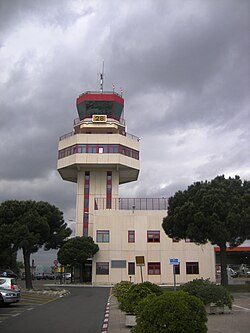Madrid–Cuatro Vientos Airport
Madrid–Cuatro Vientos Airport Cuatro Vientos Airport MCU | |||||||||||||||
|---|---|---|---|---|---|---|---|---|---|---|---|---|---|---|---|
 | |||||||||||||||
| Summary | |||||||||||||||
| Airport type | Public/Military | ||||||||||||||
| Operator | Aena | ||||||||||||||
| Location | Madrid | ||||||||||||||
| Elevation AMSL | 2,269 ft / 691 m | ||||||||||||||
| Coordinates | 40°22′14″N 3°47′06″W / 40.37056°N 3.78500°W | ||||||||||||||
 | |||||||||||||||
| Runways | |||||||||||||||
| |||||||||||||||
Madrid–Cuatro Vientos Airport (ICAO: LECU), also known as Cuatro Vientos Airport, is the oldest Spanish airport, established in 1911 and one of the three civil airports of Madrid along with Madrid–Barajas and Torrejón Air Base. The airport is located 8 km (5.0 mi) southwest of the city centre. The name "Cuatro Vientos" translates into English as "Four Winds."
Cuatro Vientos was originally an air base, which later became also a civil airport. Thus, there is a military section located on a separate apron of the airport, opposite to the civil one. It is also used as Madrid base for the Spanish Police helicopters and turbo-prop airplanes, as well as for the road traffic surveillance helicopters.
History
The Cuatro Vientos Airport provided the location for the meeting of Pope John Paul II with young people on his fifth and last visit to Spain on May 3, 2003, and for the vigil and final mass of World Youth Day 2011 with Pope Benedict XVI, on August 20–21.
Infrastructure
This airport is mainly operated by general aviation aircraft, Flight Training Organizations and flying clubs. Due to the runway length and surrounding buildings it is only possible to operate helicopters, piston engine aircraft, medium size turbo-props and small business jets. Also, due to the lack of IFR facilities, but an old NDB (CVT), it is only possible to operate VFR flights. Nevertheless, it is the headquarters airport of several FTOs, including some of the major Spanish ones as Gestair Flying Academy, Aerotec, Aerofan and others.
In the sector A-1, on the south side of the field, sits the Museo del Aire, an air and space museum mainly dedicated to the Spanish Air Force.
Accidents and incidents
- In September 1976, Douglas C-53 T.3-57 of the Ejército del Aire was involved in an accident at Cuatro Vientos AFB and subsequently withdrawn from use.[1]
- In May 2013, Hispano HA-200D Saeta of the Fundación Infante de Orleans crashed during an aerobatic show at Cuatro Vientos Airport. Pilot died and caused several injured people on the ground.[2]
References
- ^ "T.3-57 Accident description". Aviation Safety Network. Retrieved 15 August 2010.
- ^ "Crash Cuatro Vientos Hispania 200D". NBCNEWS. Retrieved 5 May 2013.
External links
